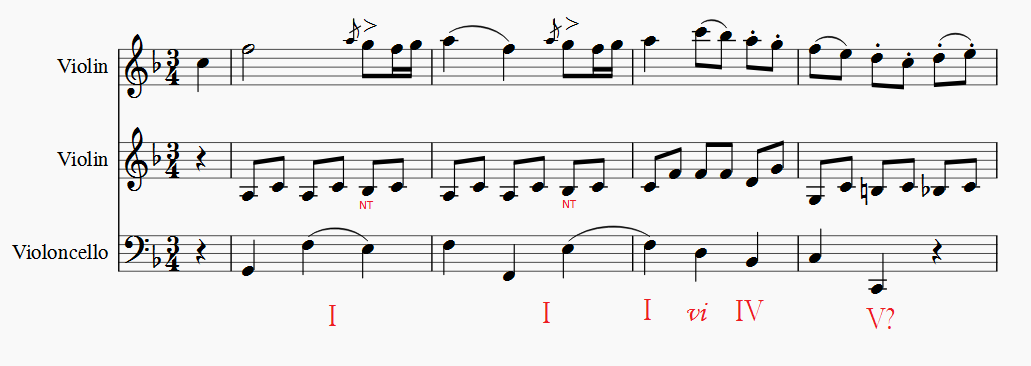I'm new to music and I'm trying to learn analysis, my question is, what chord is represented in the last bar of this excerpt? It has C in bass, so it could be a dominant chord, but rest of the notes in violin part doesn't seem like part of the dominant chord.
-
This is probably off topic as to pertaining about the rules of basic analysis questions.– Neil MeyerCommented Jul 26, 2015 at 5:20
-
1@NeilMeyer analysis is on topic.– Dom ♦Commented Jul 26, 2015 at 18:28
-
2and it is not about... identifying a song, style/genre, instrument/equipment, technique, chord progression, etc. but hey I'm not going to argue with mods if they think this is fine.– Neil MeyerCommented Jul 26, 2015 at 18:34
2 Answers
Here is a quick basic analysis of the passage in question. Note that the first note in the bass in your edition is wrong (it should be an F, and is in the Schotts Söhne edition I've copied here).
The notes under crosses are all accented non-harmonic notes; as such, they are resolving into chord tones in the following quavers. That's not to say that they don't have harmonic significance (the term "non-harmonic tone" is something of a misnomer), but the significance is suggestive more than declarative. Beethoven was clever about how he used that.
The B♭s (B in German nomenclature) in the 2nd violin in the first two bars are accented auxiliary notes that suggest vii° (and thus V ), but the B♭ acts mainly like a lower auxiliary. This is emphasised in the last bar where B♭-C is doubled in tenths (and the ninth of a dominant 9th, the D, resolving upwards would be very unusual - the D is an accented passing tone).
), but the B♭ acts mainly like a lower auxiliary. This is emphasised in the last bar where B♭-C is doubled in tenths (and the ninth of a dominant 9th, the D, resolving upwards would be very unusual - the D is an accented passing tone).
The second beat of m.3 is IV6, as I mentioned in the comments, but the appoggiatura C suggests vi7, which has a neat descending fifth relationship to ii6. The missing A you asked about in your comments is the accented passing note on the third beat - almost as if it were a suspension. Still, note the bass line: a broken chord on B♭! The subdominant is what m.3 is about; the supertonic is there because of the falling line in the first violin.
When you get to the last bar, which you were asking about, every beat has at very least an accented passing note - the chord tones in Violin 1 are every 2nd quaver, similarly for the last two beats in the Violin 2. The accented non-harmonic tones on the 2nd beat in the violins, B♮ (H in German) and D, suggest vii° of V over V, and hence confirm the dominant as a cadential point.
The whole last measure looks like V to me and I would even consider it V7 as there is a Bb in the measure.
There does appear to be a lot of non-harmonic tones in this section, but if you look start at the beginning of the measure, you can see how the harmony creates a V7 chord.
V1: (F) E (D) C (D) E
V2: G C (B) C Bb C
VC: C C -
1 + 2 + 3 +
All the notes above are the same as in the score. The parenthesis are non harmonic tones relative to a C7 which is V7 in this key. While there are 4 non-harmonic tones, they all resolve to and come from notes in the C7. Also at no other point in this measure is there another harmony implied. If the second violin on beat one was an A instead of a G, most likely the first chord would be a I6/4.
-
Thanks. In measure 3, there is obviously subdominant chord in the bass, but second note in the bass (D) looks like root of the sixth chord (as I have marked), but, if you look vertically, there are only D, F and C, so it looks like a vi7, but it lacks note A. Can I interpret it like that?– GitnikCommented Jul 25, 2015 at 23:25
-
@KrausVonKraken yes it is very typical to omit the 5th in a chord especially when you have limited voices like in this.– Dom ♦Commented Jul 25, 2015 at 23:30
-
Thank you. That was confusing me. I've analysed first three menuettos from WoO9, and I noticed that tendency, but didn't know why would they be omitted.– GitnikCommented Jul 25, 2015 at 23:32
-
1In the last bar, V with a suggestion of V of V in the accented passing tone and auxiliary. Where you have marked vi is actually IV in the first inversion - the C is an appoggiatura.– user16935Commented Jul 25, 2015 at 23:36
-
@Patrx2 It really looks like the first inversion, and C an appoggiatura, but why was on that vertical B omitted?– GitnikCommented Jul 25, 2015 at 23:46


